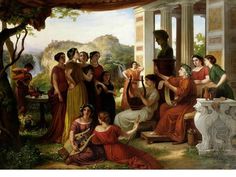Everything has an origin story, a place where it is first introduced into time and space. Phrases and ideas are no different, and a lot can be learned about the idea based on its origin story. With this in mind, the history of carpe diem can show things about the original purpose of the phrase as well as how the proceeding cultures changed and altered the meaning of carpe diem. The Roman poet, Horace, is the first person to use the specific phrase carpe diem. From that point on, the idea of carpe diem appears in many literary works throughout time, but each time it appears, there is something slightly different based on the cultural context of the piece of writing. Horace’s poem, “Odes 1.11”, presents carpe diem in a different context than carpe diem in Robert Herrick’s poem, “To the Virgins, to Make Much of Time”, and Henry Wadsworth Longfellow’s poem, “A Psalm of Life”. Each of these poems attempt to convince their audience that seizing the day is the best way to live life through logos, ethos, and pathos.

In Horace’s poem, “Odes 1.11”, he introduces the idea of carpe diem to his pupil through establishing common ground by connecting the idea to the Roman polytheistic religion. In that day, the Roman gods were considered fickle and untrustworthy. Horace cautions his pupil to not try to understand what the gods have appointed for his future because they do not know “whether more winters Jupiter has allotted” (ln 11.4). Horace extends the common ground by appealing to the pathos of his pupil’s culture, encouraging him to celebrate and focus on bettering the present rather than worry about the past or future. The young person should not sit and ponder the future, but rather he should go out and “strain [his] wines” (11.6). Horace ends the poem by telling his pupil that it is impossible to trust the future. The only thing that can be trusted is the moments being lived right now. Plans should not be created and “cut short long term hopes” (11.7). If the future is unknown there is no point in hoping for the future.
By drawing on the religion of the time as well as the Roman culture that holds pleasure at its epicenter, Horace introduces the idea of carpe diem as a coping mechanism to deal with the unknown of the future.


To the Virgins, to Make Much of Time
Several centuries later, Robert Herrick, a 17th century poet and the writer of “To the Virgins, to Make Much of Time”, takes up the idea of carpe diem and urges the young women he is writing to that they need to make the most of time because it will slip from their grasp through the use of pathos. Herrick connects on an emotional level with his audience by talking about fading beauty and the sun setting on the day. Once he connects with his audience by warning them that “this same flower that smiles today tomorrow will be dying” (lns 3-4), he urges the girls that they need to make good use of their time. He does this by comparing a person aging to the sun’s journey across the sky during the day. He says, “the glorious lamp of heaven, the sun, the higher he’s a-getting, the sooner will his race be run, and nearer he’s to setting” (5-8). Both of these images, the sun setting and the flower dying, are used to persuade his audience that time is fleeting and beauty fades.
The idea of carpe diem that he suggests in his poem is different from Horace’s poem because it is less about not knowing what the future may bring, but rather knowing that the future will only bring death and darkness.
By connecting to young women through pathos, he tells them that they need to make the most of their time because soon they will be old and their beauty will fade. Herrick is tell the virgins that beauty will fade, and only then will they be able to rest because when the day ends, all that will remain are the things that have been done.
Carpe diem is yet again redefined in a religious way by Henry Wadsworth Longfellow in the 19th century in his poem, “A Psalm of Life”. Longfellow takes what Herrick introduced and expands it through parallelism and similar phrasing between “A Psalm of Life” and religious passages. The similar structure establishes common ground and ethos between Longfellow and his audience. Longfellow’s poem is issuing a warning to his audience to take care of what they leave behind as they move into the future. “But to act, that each to-morrow finds us no farther than to-day (ln 11-12) tells readers that they should strive to better themselves each day because on day they will not have tomorrow. When that day comes all that will be left is their legacy. Longfellow mirrors common themes in religious text by reminding his readers that one day they shall “to dust returnest” (7).
His readers are told that they must seize the day in a meaningful way so that what they leave behind is something to be proud of.
Longfellow introduces a different view of life in opposition to carpe diem. Instead of living simply for the present, Longfellow urges his readers to live in both the past and the future as well. He warns against the idea of carpe diem by telling them to look carefully at the legacy they will leave behind.

Each of the previous three poets: Horace, Herrick, and Longfellow, has influenced society’s views of carpe diem. Horace is the first to record the idea of carpe diem, but his version of carpe diem has mutated and changed throughout the centuries. By the time it is reaches Herrick, it is less about not knowing the future and more about making the most of the present before the future tears everything away. Longfellow turns the concept of carpe diem back towards religion, reminding his readers that their past, present, and future shapes what is left behind when they die. Carpe Diem has developed into two distinctive strands in history: a secular view and a religious view. Albert Camus is a spokesperson of the secular view of carpe diem that has developed while Soren Kierkegaard is a spokesperson of the Christian view of carpe diem.



